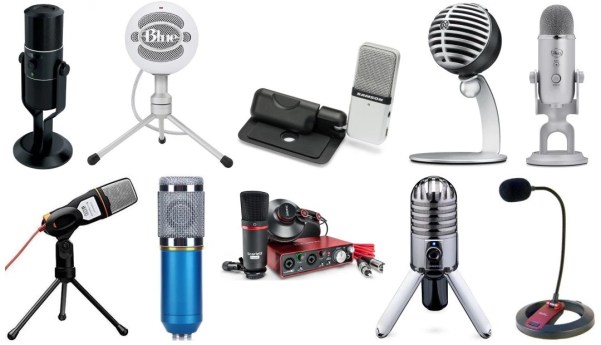Whether you’re recording podcasts, videos or streams, or playing games with friends using voice communication, the microphone is a must. Microphone for Computer. Laptop users probably think about this issue much less often since almost all of them have a built-in microphone or headset.
For the headset to work on a PC, you need special software. And podcast hosts and bloggers place high demands on the quality of recording and sound processing. Therefore, today we are talking about choosing a microphone for your pc that will allow you to record sound, communicate, and even record vocals or musical instruments.
Table of Contents
USB microphone or traditional microphone: Microphone for Computer
To figure out which is better, it is worth borrowing experience from the recording experts, the owners of home studios. And the first thing you need to pay attention to is the type of microphone connection.
USB microphones have some advantages over standard microphones, that is, those that are connected via XLR or 1/4 input.
The most important thing is that there is no need to install additional software. A computer or laptop immediately picks up the microphone and, if you have a DAW application (digital sound workstation), you can start recording right away.
USB microphones also have a built-in digital interface, so they are often cheaper than buying the microphone and interface separately. So, if you have a limited budget, then you can consider purchasing a USB microphone.
There are, however, limitations that apply to USB microphones. There are no ports for these on most mixing consoles or interfaces. Therefore, if you still want to choose the option to connect to them, you will have to look for a model with an additional XLR connector.
This matters because the remote or interface will give you more control over the equalizer and sound settings, as well as its quality.
Converting audio to digital format: Microphone for Computer
One of the functions of audio interfaces in a computer and some mixing consoles is to convert an analog signal from a microphone to a digital one to process it further.
In USB microphones, this function is built right into the device itself. It also affects some specifications that will be important when recording sound—sample rate, bit depth, and hardware latency. When recording podcasts, this will be less important than in music, but you still need to consider all the possible properties of the device.
Converting analog audio to digital is carried out by capturing a large number of samples. The speed and depth at which the samples are recorded also determine the final digital track’s quality. Thus, the sampling rate and depth values give an idea of the quality of the recording.
Sampling frequency
It is also called speed and measured in kHz (kilohertz). To cover the entire frequency range accessible to the human ear, it is necessary to use a frequency of at least 44.1 kHz, which is used on CDs. How to screenshot mac. For sound recording, this frequency is usually used as optimal. Therefore, it is crucial to consider that the microphone must support 44.1 kHz as the minimum sample rate. Professional devices often use 48 kHz or 96 kHz. This is since such equipment works with other devices and is designed to provide the highest sound quality and possibilities for its editing.
Bit depth
The bit depth determines how many bits of information will be contained in each sample on digital recordings. This, in turn, gives us an understanding of the recording’s resolution and detail. How to update mac. CDs use 16-bit depth, which is the minimum requirement for your microphone. Professional devices use 24 bits, and some USB microphones have the exact specifications.
Hardware latency
This characteristic refers to the delay between the moment the sound reaches the microphone and the time it takes to process the signal to be converted to digital and ready for playback. This characteristic is less critical for those who write the text, but it is fundamentally essential for the musician. Best computer microphones. This indicator triggers when you record a new track while listening to the old one or several others through headphones. Generally, the higher the microphone quality, the lower the hardware latency. And this is the reason why musicians prefer more expensive models.
Some USB microphone manufacturers have solved this problem by including headphones on the microphone body to make music sound in real-time.
Condenser microphones or dynamic: Microphone for Computer
Many people know that there are two main types of microphones. But not everyone has a good idea of why and which ones are suitable for what. We assume that the PC microphone will not play the role of a sound amplifier. That is, it will not be used on stage.
When creating microphones, the same implied by manufacturers, a USB microphone for a computer will be designed for recording. Therefore, most USB microphones are condenser microphones rather than dynamic ones.
Condenser microphones have wider audio frequency and better transient response, so they are often used for recording, even in studios. They are inconvenient for stage use, also due to their more compact size and sensitivity when it comes to loud sounds. Best true wireless earbuds 2021. This is where the durability of dynamic microphones and their size are much more convenient.
However, some manufacturers began to include a USB port in the design of dynamic microphones to be used both on stage and during recording. This is a kind of travel option, which, however, is not ideal for the home. An example of such a microphone is the Audio-Technica AT2005USB.
Diaphragm size: Microphone for Computer
The microphone diaphragm is another parameter that varies from model to model. It is the membrane that first collides with the sound wave. Large-diaphragm models are versatile and sensitive. They do a much better job of recording low frequencies.
The small-diaphragm well suited for recording acoustic instruments such as guitar and treble. If you are recording something that implies acoustic music, this is something to consider.
Polar radiation pattern: Microphone for Computer
Microphones pick up sound in different ways and from different directions. In some cases, an omnidirectional microphone is more suitable for you, which will pick up the environment, etc. But when it comes to communicating and recording videos, you’re better off choosing a microphone that picks up sound from one direction and focuses on the voice. This is how cardioid microphones function. They got their name because of the shape that looks like a heart. They often pick up sound from the front, partially suppressing other sounds. The semi-cardioid polar diagram has an even narrower direction and is most suitable for recording.
An omnidirectional microphone required when recording multiple people, such as a group podcast. Or when recording various instruments in a small room.
The multi-directional microphone is another option that combines the functionality of both. These microphones have a switch that adjusts the pickup of sound. If you are not sure what type of recording you need, this microphone is the best choice.
The functionality of USB microphones: Microphone for Computer
Standard microphones differ significantly from USB microphones. Since the latter is designed to work with specific recording software, they usually get dedicated buttons and controls on the body. There will almost always a volume control on the microphone, in some cases a directional control.
Some models are equipped with real-time monitoring functionality to match the sound to previously recorded tracks.
A mute button also appears on some microphones and allows you to mute the signal. This is convenient for those who play games and communicate via voice chat. Low-pass filtering blocks extraneous noise and sounds.
The Blue Yeti one of the most popular microphones used by many bloggers and gamers. It not only delivers high-quality audio but also offers an affordable price tag. The functionality of this microphone is convenient, and after a while, you will not be able to wean yourself from it. Blue Yeti is suitable for both Mac computers and Windows devices.
Blue Yeti received four modes of operation: single voice recording, conferences, interviews, and music recording. The versatility of this device best explains its popularity. You can connect headphones to the Blue Yeti, and a stand thought out in the design, which allows you to adjust the microphone’s location.
Audio Technica: Microphone for Computer
The Audio-Technica AT2020USB + is a vocal recording model, but its characteristics offer much more than it costs. The microphone connects via USB and sits directly on the table. There is also a headphone jack on the case, so you can hear what you say in the microphone—not recommended to use it simultaneously with columns for more than obvious reasons. In short, this microphone is versatile and convenient for any task.
When traveling and in any environment where you do not have access to the primary microphone, Samson Go comes to the rescue. This tiny microphone plugs directly into your computer (both Mac and PC), requires no drivers, and can sit on your desk or cling to your laptop.
Plus, the Samson Go received a headphone jack, frequencies from 20 Hz to 18 kHz, and even a carrying case. It is suitable for both chatting and recording podcasts or videos. And most importantly, he can always be with you.
You may need a microphone for a variety of tasks. Someone wants to record their videos. Someone plans to record music or even create entire orchestral compositions using a computer and musical instruments. In any case, to select the microphone suitable for your application, you need to understand the basic requirements and characteristics. Now that you know microphones’ parameters, all that remains is understanding your goals and making a choice.











